Cullings Coach Services Double Deckers
Cullings Coach Services Double Deckers
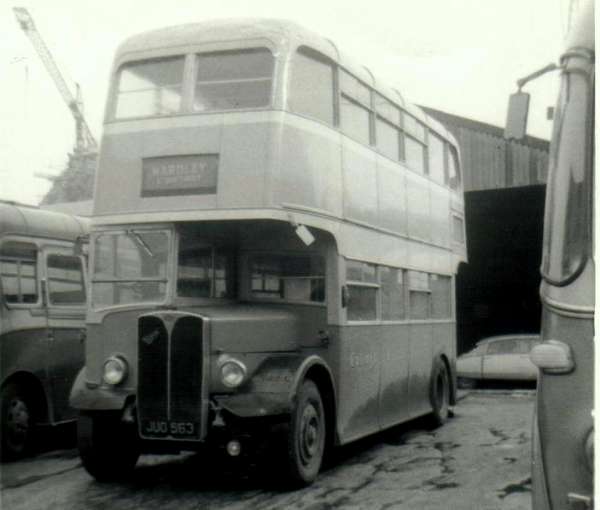
My interest in buses from the 1950/60's has been re-kindled after many years. I have spent many quiet moments reading about the informed comments and facts from your contributors on the Old Bus Photos website. I took several photos when I was thirteen to 15 years old on an old 126 camera in Norwich. The cost of too much film developing then exceeded my pocket money though! Many of my best photos of ECW bodied buses were sent to the TPC who I believe had a flood (or some disaster) in their publishing office and my photos were lost.
In Norwich there was an independent company called Cullings Coach Services and among their services they ran two stage carrying routes to villages in Norfolk. At that time they operated three double deckers, two AEC Regents and a lowbridge Bristol K. The Regents (MkII's?) were fascinating to me as the main company who ran services in Norfolk was Eastern Counties with standard Bristols, and these AEC's made a real change from the norm. I attach a picture of JUO563 taken in 1969, in Cullings yard in Ber Street, Norwich. I wondered if anyone could give me more details about this bus. I am sure it is Weymann bodied and it may be ex Leeds. They also had a similar vehicle Reg. No. OTW 922, but the only picture I have of this is a rather blurred.
Graham W
28/06/13 - 14:13
JUO was a Devon registration. The bus is certainly an AEC, but I think a III rather than a II. Bodywork is Weymann, and as Devon General had a large quantity of this combination I reckon that is the origin of this vehicle. (Incidentally, most were synchromesh, not the more usual pre-selector gearbox fitted to the III, and hence sounded more like the similarly equipped later Regent V and Renown.)
Stephen Ford
28/06/13 - 14:15
It was fleet number DR563 in Devon General fleet, Regent III new 1948 chassis 9612E1238 Weymann body number M3277 H30/26R I believe.
Les Dickinson
28/06/13 - 17:53
The chassis designation 9612E indicates a 9.6 litre engine, air brakes and an epicyclic gearbox, and the very early Regent III deliveries to BET operators were of this specification, which AEC regarded as the standard. However, the BET group, never a fan of preselectors, wanted a version with vacuum brakes and sliding mesh gearbox, and subsequent Regent IIIs for the BET were usually of this pattern, which was also favoured by some municipalities. AEC offered yet another variant with the 7.7 litre engine coupled with vacuum brakes and crash box. It is surely noteworthy how manufacturers were receptive to customer preferences in the decade following WW2. How things changed dramatically somewhat later at Leyland under Donald Stokes!
Roger Cox
28/06/13 - 17:53
DG to Cullings about July 1960 according to Ian Allan DC book.
Les Dickinson
28/06/13 - 17:54
The Regent was before my time but the Bristol K - ex West Yorkshire
HWW 874 - was still running until early 1972 when it was replaced by a brand new Bedford which must have been a surprise to it's regular passengers. Although Cullings ceased business over thirty years ago, the yard and adjoining office is still there.
Nigel Turner
29/06/13 - 07:36
I have always understood that Cullings were from Claxton, which is 8/10 miles outside Norwich - did they always have two depots?
In the 1950s Cullings operated a Strachans lowbridge-bodied Daimler CVD6 ex Viking of Preston, which must have been virtually new when Cullings acquired it. There was a pic on the net until recently, but i can't find it now.
David Call
29/06/13 - 09:46
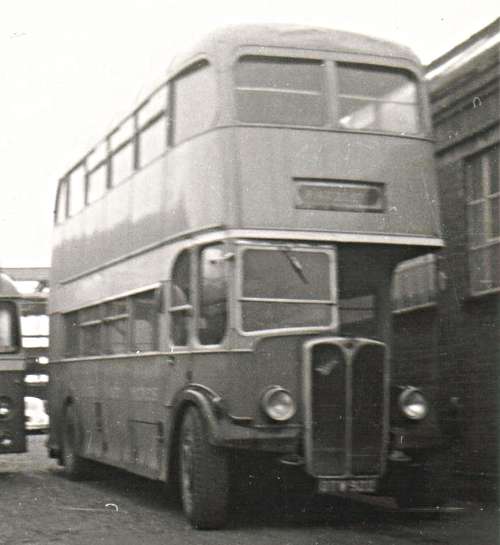
This is the poor image I have of the other AEC Regent III working for Cullings Coach Services, of Norwich in 1969. Registration No. is OTW 922, and again I would like any information.
Thanks to everyone who responded to the last picture I sent in.
Worthy of mention is the wonderful Cullings livery on these D/D's. Grey up to the bottom of the lower deck windows, with the rest being a rich yellow, and cream relief bands. The fleet name was in old-fashioned script in large letters, in yellow and black.
Yes, the yard is still there, and the yellow painted window frames on the elevated office are still just about hanging on. I must get a picture before they tear the place down!
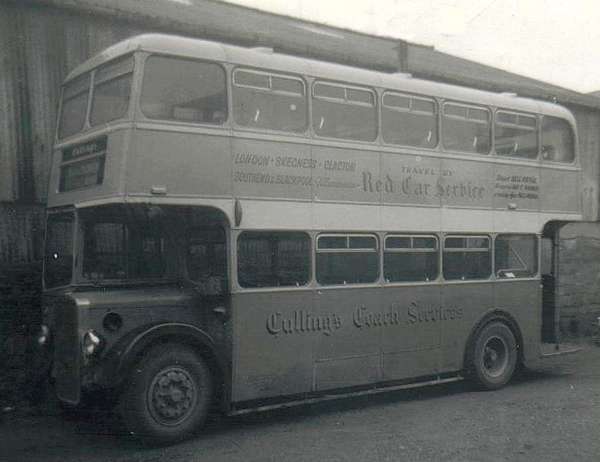
Just to complete the trio, here is the best photo I have of HWW 874 working for Cullings of Norwich, with ECW L27/28R body. Oh, I wish I had a better camera then!
Now, was this a K6A?
Graham W
29/06/13 - 11:46
David Call is correct in saying that Cullings originated from Claxton. Mr. Culling (senior) ran the windmill in that village which explains why some coaches had a windmill logo on them. As well as the yard used as a terminal for the bus services there was also a modern depot at the other end of Ber Street just past the entrance to Jolly Butchers Yard. Again the building still survives and has a "blue plaque" on it for reasons I cannot now remember.
Latterly the mill site was used for Cullings haulage fleet but was sold by A.A. Culling junior in 1971.
New vehicles bought by Culling often had registration numbers ending in "800". They also acquired the Red Car Service (Roberts) of Norwich in the 1950s and this was run as a nominally separate company.
Mr. Culling sold the business around 1980 but sadly it failed in 1981 in circumstances which apparently can not be fully described due to libel laws.
Like Graham W, I too wish I had a better camera in those days which is why I am not submitting any of my (few) Cullings photos.
Nigel Turner
29/06/13 - 15:23
OTW 922 was an Essex registration so may have been bought new or Colchester Corp, maybe?
Les Dickinson
29/06/13 - 16:52
They also operated at some time around 1960, an ex-Hants & Dorset Guy Arab I with a Strachans utility body which had been so heavily rebuilt it was unrecognisable.
Chris Barker
29/06/13 - 16:53
Cullings also operated a Bristol LWL with ECW (Queen Mary) bodywork, new to Bristol Omnibus as 2818 (OHY 990).
An earlier vehicle was Bedford OB JNG 276 with a Duple coach body.
Dave Farrier
30/06/13 - 07:29
There are more Cullings pictures here:- www.flickr.com/photos/one and www.flickr.com/two
David Williamson
30/06/13 - 07:31
Regent III OTW 922 is not a former Colchester Corporation bus, Les. Peter Gould's fleet list of that operator does not include this bus. Incidentally, the old mill that was once owned by the Culling family may be seen on this site:- http://claxtonpc.norfolkparishes.gov.uk/history/ (scroll about halfway down the page).
Roger Cox
30/06/13 - 07:31
OTW 922 was certainly not ex-Colchester, and with an Essex registration I doubt that it would have been new to Cullings. There were a fair few independent operators in Essex running double-deckers, but very few indeed bought them new. Any ideas?
David Call
30/06/13 - 07:32
Ex-West Yorkshire Bristol double decker was a K6B all the time it was operated by WY. I suppose there's a chance that Cullings did an engine change. To my knowledge WY never had any K6As.
David Rhodes
01/07/13 - 07:06
OTW 922 was one of those very rare vehicles - a double decker new as a non PSV. I think it originally worked at one of the oil refineries in South Essex, possibly Shellhaven.
HWW 874 was definitely Bristol engined.
Nigel Turner
01/07/13 - 07:07
Graham, as David rightly points out, HWW 874 was indeed a K6B. It was new to West Yorkshire as their 785 in 1950, and was later renumbered DB47. West Yorkshire's only dalliance with the K6A came in 1944/45, when five Strachans lowbridge utility-bodied examples arrived (707-711: EWU 987-991). They were powered by the well-known AEC '7.7' engine, and apparently were fitted with upholstered seats rather than the usual austerity wooden slatted ones. West Yorkshire replaced the AEC engines with Gardner 5LW units in 1946/47.
Brendan Smith
01/07/13 - 07:08
A long shot regarding OTW 922 but I'll give it a try. Pest Control Ltd. of Cambridge had one or more of these Weymann bodied Regents for staff transport. One was registered in Cambridge, HER 28 but could they have had another with an Essex registration if it worked in that area?
Chris Barker
01/07/13 - 07:08
Brilliant, thanks chaps. I have found out my photos were taken in January 1969. Later that year on a glorious sunny day, my mate and I went for an adventure, by travelling on the K6B to Rockland St Mary, one of the villages near Claxton, and caught the same bus back to Norwich. We were only 14 years old then so it was an adventure for us and it depended on our pocket money what fare we could afford. I am trying to remember the sound of the engine that day, but I for one couldn't remember whether it was as Bristol, and probably wouldn't have known what a Bristol engine even sounded like.
My father took me past the Claxton, Mill Lane, property later, I expected to see a wonderful bus garage, stupid of me, it was just a collection of corrugated iron sheds!
Graham W
03/07/13 - 06:51
Having rummaged in the archives I can now confirm that OTW 922 was an AEC Regent III with Weymann H30/26R body new to Shell at Thames Haven, Essex in 1949. It passed to Cullings in December 1962 and stayed until December 1968.
Nigel Turner
04/07/13 - 06:02
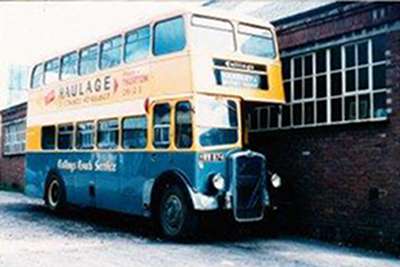
The on going thread on Cullings set me searching through my photo collection and I found this colour shot which I bought on a rally stall some years ago. I literally thought it would add a bit of colour to the topic.
Thank you, Brendan for clearing up about West Yorkshire's K6As. I had quite forgotten about these utility interlopers. What an informative site this is!
David Rhodes
05/07/13 - 06:18
Was OTW 922 a one-off, or did Shell buy other double-deckers? Was it a 9612E, like JUO 563?
David Call
05/07/13 - 15:56
In the '40's and '50's London Transport's AEC Regent STL's also ran to Shell Haven, the most Easterly part of Essex LT penetrated.
Chris Hebbron
06/07/13 - 06:13
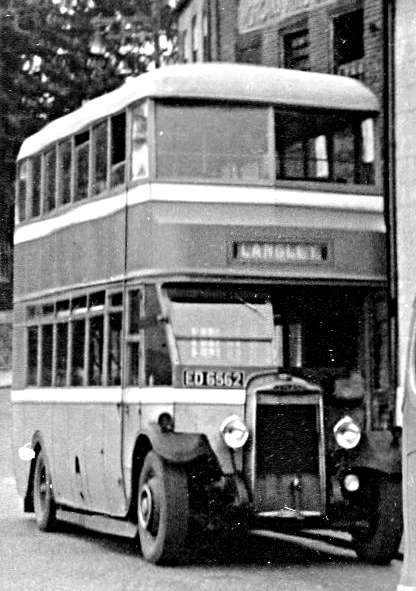
Am a great enthusiast of Cullings Coaches. Very pleased to view photos and gain information. Enclose photo of the first decker purchased in 1947 Ex Warrington Corporation No29 Leyland TD1 with Brush body. Not good but the only pic. that I have been able to obtain of this vehicle.
Wally Nickerson
10/07/13 - 08:02
The picture of Cullings' first double decker - a Leyland TD1, ED6562 - is interesting, as it raises questions in my mind about possible modifications made to it from it's original entry into service. The radiator is long for a TD1, and is presumably a "Cov-Rad" conversion (Coventry Radiator Company), which was quite common in the immediate post-war period on Titan and Tiger coaches. Did Warrington or Cullings (or a dealer) do this? The other point of interest is the body design. The front upper deck is quite a modern style for a TD1, the vee-front is like those built by Short Bros and English Electric. In contrast, the lower deck side windows resemble those of an earlier generation. The main windows appear to be of "normal" height, but the windows above resemble those common on earlier generation buses of the mid-twenties and earlier. But a TD1 with the front-end style and the lower deck side windows seems to be anachronistic. Was the bus built like this, or were the lower deck small windows added later (by whom?), or was the upper deck front originally to an older style and modified later (perhaps a low bridge accident)? Or is my imagination just running wild? (must be the summer heat).
Michael Hampton
10/07/13 - 17:28
Before you go off with heatstroke, Michael H, what was the purpose of the CovRad conversion? A larger radiator, maybe, yet it took from 1929 to the postwar era for overheating to raise its head? To make the vehicle look more modern? I hardly think so! So why?
Chris Hebbron
11/07/13 - 08:36
In Buses Annual 1970, there is an article by G. R. Mills entitled 'A Nostalgic look at North Norfolk' and the author mentions Culling's in glowing terms. He states that "Culling of Claxton is undoubtedly the most interesting of the stage-carriage operators serving Norwich, as the weekday workings from Surlingham and district into the city are provided by double-deckers which terminate in the cobbled Ber Street, outside the former premises of Red Car, now part of the Culling organisation"
Mention is made of some of the vehicles operated, but the only double-deckers referred to are a Daimler CVD6 with Strachans lowbridge bodywork, and two Weymann-bodied AEC Regent III's, one of which was purchased from Shell Petroleum, who had used it solely for staff transport. Sadly no further details of these interesting vehicles are given.
The author does give more of a flavour of Culling's coach and single-deck fleet in his article however, and mentions an ex-South Wales AEC Reliance with Weymann dual-purpose coachwork "smartly attired in Culling's yellow, grey and ivory livery", as well as six Reliances purchased new. He also notes that four ex-Bristol Greyhound Bristol LWL6B / ECW coaches were operated, and that they looked very handsome in Culling's colours. (There is a black and white photograph of OHY990 pictured on a visit to Great Yarmouth accompanying the article). Other vehicles taken into stock included a Dennis Falcon L6 / Duple coach, an ex-Aldershot & District Dennis Lancet UF with Strachans rear entrance body (KOT600), an Atkinson Alpha with Trans-United bodywork, and a rebodied Seddon Mark IV, which originally sported a body by Yorkshire Yachtbuilders. (Again details are somewhat scant, but there is a picture of a Plaxton-bodied Seddon belonging to Fred Wagg of Dersingham, bearing registration EX6410, which originally carried a Yorkshire Yachtbuilders body. Whether it came from Culling's is sadly not recorded). Mr Mills goes on to say that a Bedford VAL was acquired when only twelve months old from Yelloway of Rochdale, and an AEC Reliance was purchased from Creamline of Bordon when only three years old.
The article also relates that Culling withdrawals usually found good homes, but that (Chris Y, please have your tissues at the ready) exceptions were "two utility Bedford OWBs which were buried under several tons of earth in 1954, to form a hard standing for the Culling's Haulage fleet".
The author obviously holds the company in high regard, writing that "in keeping with an operator of Culling's calibre, the company has had a modern garage constructed in Ber Street in recent years to house the entire coach fleet". Culling's certainly had an interesting fleet according to the article, and were not averse to having an eye for a bargain when the opportunity arose either.
Brendan Smith
11/07/13 - 12:35
Thanks indeed Brendan for your considerate and accurate estimate of my emotions on reading of the fate of the OWBs. Fortunately I always keep a stock of tissues available, and this news warrants the start of a new box. How could any operator do such a thing I wonder - I wonder if the little champions could be exhumed ?? Perhaps that's carrying respectful enthusiasm just a little too far, but the thought did occur !!
Chris Youhill
11/07/13 - 12:37
Despite being painted in the company livery, and numbered and registered as one of the fleet, Dennis Lancet UF KOT 600 was never owned by Aldershot and District. It was operated on hire from Dennis from 1st February to 30 November 1953, after which it was returned to the manufacturer. It then went to Simmonds, of Great Gonerby, near Grantham, and subsequently to Cullings who eventually passed it on to Blue Bus of Slough. At some point in its life its Strachans B41R body was rebuilt with a front entrance. The interesting tale of the demonstrators operated by A&D may be found here:- www.dennissociety.org.uk
Roger Cox
11/07/13 - 16:13
In response to Chris Hebbrons query about the Cov Rad, I know nothing of the origins or reasons for the fitting of these items. Received wisdom in my young enthusiast days (1960's) was that they were intended to be a modernisation of older vehicles. Presumably TD1s and TD2s and equivalent Tiger models with their original short radiators were perceived as very old - a Cov Rad with a rebuild or a rebody was the "poor man's answer" for a more modern look. But I've never followed up on that impression to check it's validity. Interestingly, early AEC Regents had a shorter rad than later models, but there was no equivalent Cov Rad conversion for these. But I think some operators swopped the long and short AEC radiators around at overhaul, but I believe this was just for convenience rather than any "modern look" policy. Maybe someone has a Cov Rad advert for the period, which might shed light on the reason for their aim in selling these items.
Michael Hampton
11/07/13 - 16:13
I'm sure the rad conversion to ED was made by Warrington and I understand a diesel eng. fitted also.
My dad was a friend of Albert Culling junior and I spent much time down at the Mill yard at Claxton as a lad. It is true that vehicles ended up in the pit although some were pulled out later and sold for scrap. As has been said there were many makes over the years four new Tilling Stevens came between 1948 and 1950. Have been trying to find photos can anyone help. There were 12 double deckers and 1 open top over the years. The first buses in 1921 were model T Fords and then over the years came Graham Dodge, Chevrolet, Commer, Dennis, Gilford, Crossley, Bedford, Leyland, Albion, TSM,
AEC, Daimler, Atkinson, Seddon, Maudslay, Guy and Bristol. Keen to view any photos, likewise if I can help am happy to do so.
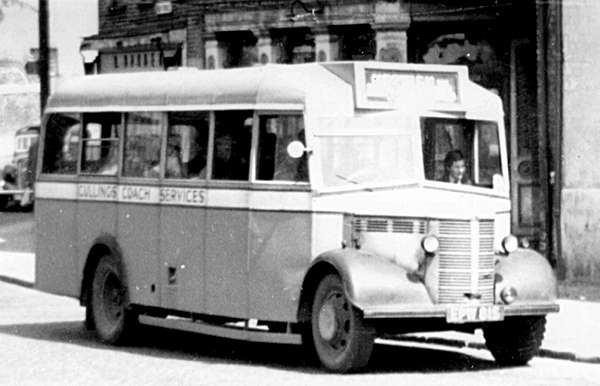
Enclosed photo of first OWB EPW 815. This bus did not end in the pit.
Wally Nickerson
14/07/13 - 07:55
Thanks for the info regarding KOT 600 Roger, and the link to the Dennis Society website. Fascinating indeed, and it just goes to show that things aren't always as they seem at first glance.
Brendan Smith
15/07/13 - 09:56
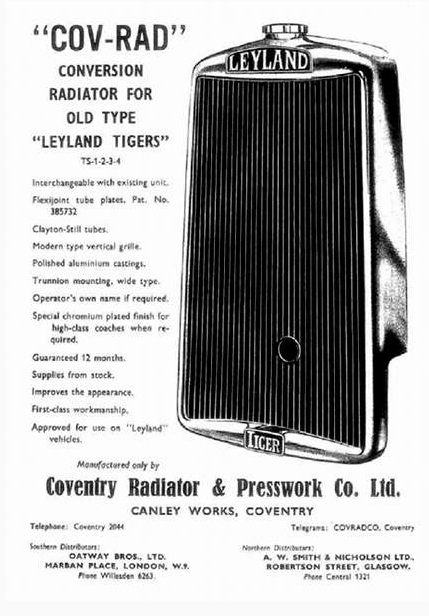
"I've managed to trace a Cov-Rad poster from the period and you can see that two selling points give the answer that I posed and which Michael H answered correctly:
- Modern Type Vertical Grill
- Improves the Appearance.
Incidentally, the Coventry Radiator Co. were big suppliers of radiator matrixes to Leyland anyway."
Chris Hebbron
16/07/13 - 07:47
Well done, Chris H for finding the Cov Rad advert! It just proves again that "beauty is in the eye of the beholder". Whether or not we think it is a design which improved an old Leyland bus, clearly there were many who did. But within a few years (1950-55 era), it all changed again with underfloor-engined single-deckers and plain fronts, and double-deckers with "new look" fronts (or tin fronts). And there are some fantastic coach designs of that era on this site, too - with comments to suit the beholders' eyes!
Michael Hampton
18/07/13 - 07:32
The problem is that the Cullings bus looks 'tired', which is hardly helped by the more modern radiator. However, this ECW re-bodied Crosville looks the bees knees, and the rad seems to enhance the overall appearance. SEE: http://tinyurl.com/ob6rf4p
Chris Hebbron
19/07/13 - 08:47
You are so right Chris, Cullings Ed not only looked tired, but it was tired. Nick named "old faithful" by drivers , conductors, and passengers alike. It finally came to an end in 1953.
Wally Nickerson
19/07/13 - 14:37
I used to think the Cov-Rad was horrible but I changed my opinion. It is rather stylish and my initial dislike was based around the fact that it was usually fitted to vehicles which retained their original early thirties style front wings and this cancelled out the attempt to improve the frontal aspect of the vehicle. However, I've seen one or two coaches where the front wings have apparently been built up to something like PS1/PS2 style, resulting in a far better appearance. I do agree with Chris H though, the Crosville decker looks mighty fine!
Chris Barker
29/07/13 - 07:41
Just to confirm what others have said - OTW 922 was owned by Shell Refining and Marketing as a non - psv for staff transport, also serving families of staff living in company housing on site. It was the first double decker bus I rode on as a small boy. It was dark blue with a small gold Shell pecten on each flank. They only had one - all others in the fleet were single deck. Later on I learned that it had been a constant source of concern that it might be inadvertently driven through one of the the many pipe bridges around the site, most of which were less than the height of the bus. I was also told that it had been purchased as a cancelled export order. All the instructions stamped on the engine e.g. dip stick etc, were in Afrikaans.
Nick Webster
29/07/13 - 14:38
It's amazing how subtle changes can make a world of difference. I'd earlier said I wasn't keen on the Cov-Rad conversion, admittedly constrained by it being made as a quick bolt-on conversion. Then I recalled the posting of the Gilford Zeus. There is a similarity, yet it's a radiator which I think is really stylish for its day. SEE: www.old-bus-photos.co.uk/
Chris Hebbron
30/07/13 - 07:06
The ex Viking Strachan bodied Daimler was the only double decker entered in the First British Coach Rally, held at Clacton on April 17th 1955. The driver, K.A. Smith-Howell, was awarded a pewter mug for his trouble according to the April 20th 1955 issue of "Passenger Transport" which also carried a photo of the vehicle.
Nigel Turner
30/07/13 - 12:33
Yes, Chris H, context is everything! The comparison of the Gilford Zeus rad and the Coventry Rad Co Leyland replacements is very apt. I guess about 12/15 years separate the two - 1932 for the Gilford and 1945 onwards for the Cov Rads.
Other input on this site has mentioned body designers who have moved from one firm to another, and producing similar designs for their new employers. Now this makes me wonder if someone from Gilford, which closed in 1935, ended up at Cov Rad by 1945??
Michael Hampton
31/07/13 - 07:42
A well-founded thought, I'd say!
Chris Hebbron
I lived in Surlingham from late 1958 until about 1963 and travelled to school on Cullings buses during that time.
My favorite double decker was JUO 563, really quiet, smooth and better, in my view, than the Eastern Counties KSW6s I used for the second part of the journey.
Somewhere I have a fleet list I compiled around 1961.
The Strachen bodied utility guy had been heavily rebuilt, and had cloth seats. The vehicle was with Greyhound of Sheffield (in rebuilt form) before it came to Norfolk. It was in the fleet when I arrived in 1958 and mostly provided the Bergh Apton service.
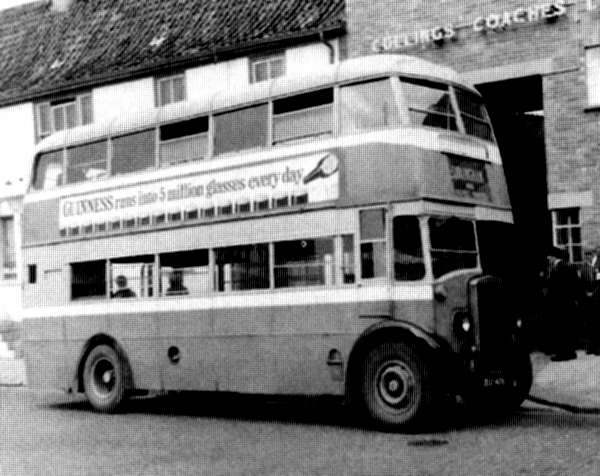
Before the two AEC Regent 111s (OTW was from Shellhaven, this was confirmed Buses Illustrated at the time), there were two Leyland double deckers, an ex Leeds TD5 and an ex LT STD type TD4, one of only two, I believe, that found new owners in the UK. This bus, incidental, appears in Ken Glaziers 'London Bus File 1955 - 62', being pictured outside the Ber Street garage. The livery of these two featured grey between decks and differed from the Regent 111s in this respect.
The STD 'died' when it suffered rear suspension failure on Trowse hill one evening. Its LPTB origins were betrayed by the very London moquette seating.
I confirm that KOT 600 had a front entrance when it arrived at Hardley.
Cullings had other vehicles not mentioned. There were two Regal IVs with Yeates Riveira C41C bodies, and a Bedford SB with front entrance RIveira body work.
There were four very nice SBs with Duple Butterfly bodies, all 800 registered and bought new. They sometimes covered as buses.
Not mentioned so far is a small Commer 31 seat bus (possibly Mulliner) which I believe was originally non-PSV. This went like the wind.
There were two Reliances with Yeates Europa bodies, the then pride of the fleet. One won the Brighton Coach Rally Concours event and the other ferried Norwich City about. We hired the former on a couple of occasions, to go trainspotting in distant places. Then rode well.
When I first arrived there were still several Duple Half cabs in the fleet, mainly on Dennis chassies. I recall watching four or five of these return to Ber Street one evening - but they disappeared soon after.
The only Bedford OB I recall (and rode on) was a full fronted Duple.
There was also a very late model Burlingham Seagull for a time.
Red Car operated a C41C Yeates Regal IV (a former driver let me have a photo of this), as well as a Commer/Butterfly Duple.
I also recall the Bristol ECW double decker (after I moved away) and much later the Willobrook Reliances which ran a fairly long distance route to Stowmarket and, I believe, Ipswich.
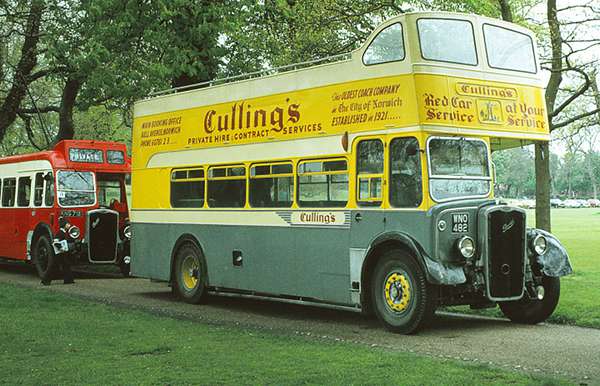
Many years later I took a lovely photo of Cullings open top Bristol/ECW KSB, converted and acquired from Eastern National.
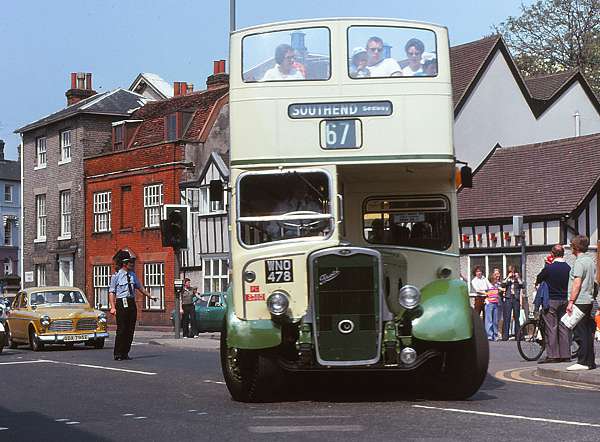
I attach a scan of the STD, a shot of the open topper and one of a similar conversion in EN colours
Dudley Jones
14/01/14 - 08:17
Although Dudley hasn't mentioned it, the photos of the two KSWs were taken at the start of the Ipswich - Felixstowe Historic Vehicle Run, some time in the mid to late 1970s, I guess. WNO 482 is parked in Christchurch Park, Ipswich awaiting the start of the run while WNO 478 has just left the bottom (narrow!) exit of the Park, done a sharp right and is now doing a 180 degree turn to the left. From personal experience in a KSW, I can tell you that it is an interesting manoeuvre as you basically had to aim at the policeman and then swing the wheel hard round just before you hit him. Nowadays a different and easier exit from the park is used. The 44th Ipswich - Felixstowe Run will take place on May 4th this year and, all being well, at least one ex Eastern National KSW should take part. With regard to Cullings Norwich - Stowmarket (rail replacement) service, the only journey which extended to Ipswich was, I think, a late night service operated by Eastern Counties. Most Stowmarket journeys were operated by R.O.Simonds of Botesdale whose grandsons still work the Norwich - Diss section in 2014.
Nigel Turner
15/01/14 - 15:05
Nigel Turner is correct about the location of the open toppers - how I wish I could get to those events (I now live in the Wye Valley).
As an aside the second hand bus painting in the 1950s; early 1960s was done, not by a professional, but by an employee who lived in Surlingham, a Mr Mean. The lettering, particularly, was a work of art and superbly done.
Dudley Jones
20/01/14 - 08:04
Thanks Dudley for some interesting facts. From 1957 I lived in Kirby Bedon and was an apprentice mechanic working in Norwich and we did some work for Cullings. I recall all vehicles mentioned by you and have many photos. A couple of points, Commer OUA 76 had Saro body and the full fronted OB KVF 261 was bodied by Plaxton I have fleet list 1920 to 1959. Would be most interested to view your 1961 list if it turns up. I would be happy for Old Bus to forward my e-mail address to you if this is possible.
Wally Nickerson
20/01/14 - 15:45
Many thanks to Wally Nickerson for the information.
I did wonder whether the OB was Plaxton bodied. It was not a vehicle I saw very often, and travelled on it only one sunny morning to school.
I must find my fleetlist. I would love to exchange information by e mail if that can be arranged. I stayed with my caravan at Kirby Bedon last September, in the gardens of the former pub.
Dudley Jones
27/01/14 - 15:49
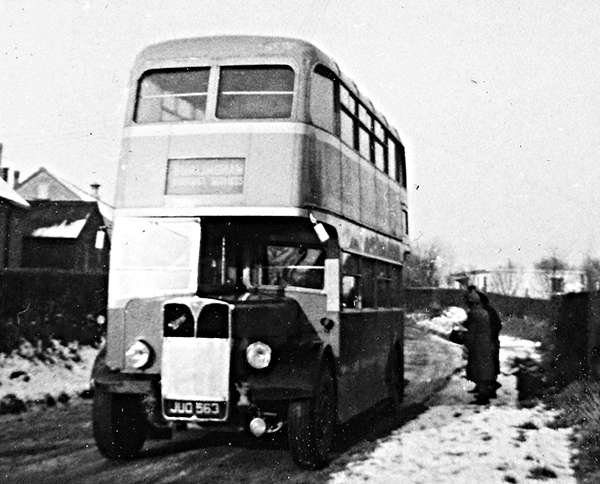
Herewith is a photo of AEC Regent III JUO 563 on the Surlingham and District Service about 1961. The location is opposite Surlingham Primary School.
Dudley Jones
28/01/14 - 06:53
Excellent rural photo of JUO 563 from Dudley. With reference to the Guy previously mentioned If I remember correctly it was used for Berghapton services on Saturdays and during the week took workers to the turkey factory at Gt Witchingham passing through Hall Road in Hainford which would have taken directly passed my house. Prior to the Guy was a Daimler CVD6 with Strachens body.
Wally Nickerson
29/01/14 - 15:35
It may be correct that the Guy did the Berg Apton services at weekends, I only rode it once or twice.
It was certainly rare on Surlingham services. I seem to remember that the little Saro bodied Commer mostly worked to Berg Apton.
On occasions the Commer would run our evening service to Surlingham. I liked that because, although they managed to get almost 60 passengers on one way and another, it went like the proverbial 'bat out of hell'. Its driver relished the bus, and often got 60+ out of it downhill towards Kirby Bedon.
The nice thing about Culling was that you were never sure what would turn up in the morning. One of the Duple SBs would come when the double decker was otherwise not available. They were quite luxurious, including quarterlights, etc. KOT 600 was an occasional, as was the Commer. Also the AEC or Bedford versions of the Yates Riviera were not uncommon.
The thing that was not nice was the route home on Tuesdays and Thursdays.
On those evenings we were treated to a trip to Hardley, with a turn round at the garage, before eventually reaching Surlingham from the Rockland direction. This added another 20+ minutes to the trip.
Rockland, incidental, seems to be a good place to see Ospreys, or it was last September when I enjoyed an hour watching them fish at Rockland Broad.
Dudley Jones
03/02/14 - 07:16
I recently looked through old editions of Buses Illustrated and Buses.
Reporting of Cullings was sketchy, but BI does confirm that the second Regent III/Weymann came from Shellhaven (where single deck Fleetlines were, apparently later purchased new).
Back at Ber Street the April 1961 edition of BI states that Culling acquired KOT 600 from Simmons, of Great Gonerby. This is described as Dennis Lancet UF with Strachens B41R bodywork that 'was lent to Aldershot and District for several months when new'.
The November 1961 issue says 'KOT 600 the experimental 1953 Dennis Lancet UF bus is now B41F'. It sounds as if Culling either converted themselves, or had if done locally (Mann Egerton perhaps?).
Dudley Jones
05/02/14 - 07:02
I have photo of KOT 600 with Reliance, Gt. Gonerby (did Simmons trade as Reliance). The photo shows it with rear entrance, Hence I,m sure Dudley is correct it was converted at the time of entering service with Cullings. Again sadly no one around to put us right.
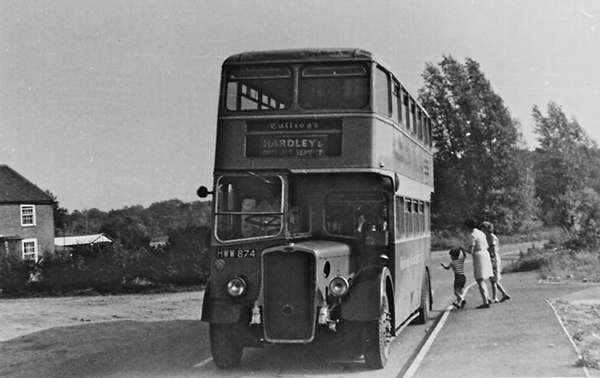
I enclose another rural photo, this time Bristol HWW 874, not Hall Road Hainford this time but in Claxton Street.
Wally Nickerson
08/02/14 - 15:43
I thought it was time I dug out my list of the thirteen double deckers owned by Cullings.
They were:-
ED 6562 Leyland TD1/Brush H30/26R ex Warrington Nov 1947
HL 9063 Leyland TD5c/Roe L24/24R ex West Riding Jun 1949
FNW 708 Leyland TD5c/Roe H31/25R ex Leeds Jan 1952
CRU 704 Leyland TD4/Brush L27/26R ex Hants & Dorset Sep 1952
CRN 59 Daimler CVD6/Strachan L27/28R ex Viking, Preston Apr 1953
DLU 406 Leyland TD4c/Leyland H30/26R ex London Transport Jul 1955
DCR 685 Guy Arab I/Brush L27/26R ex Greyhound (Alexander) Aug 1957 (new to H & D)
JUO 563 AEC Regent III/Weymann H30/26R ex Devon General Jul 1960
OTW 922 AEC Regent III/Weymann H30/26R ex Shell, Thames Haven Dec 1962
HWW 874 Bristol K6B/ECW L27/28R ex West Yorkshire Jan 1965
WNO 482 Bristol KSW5G/ECW O33/28R ex Eastern Counties Mar 1973 (new to ENOC)
VVF 215 Bristol LD5G/ECW H33/27R ex Eastern Counties Jul 1975
DAU 434C Leyland PDR1/1/Metro-Cammell H44/33F ex Nottingham Apr 1977
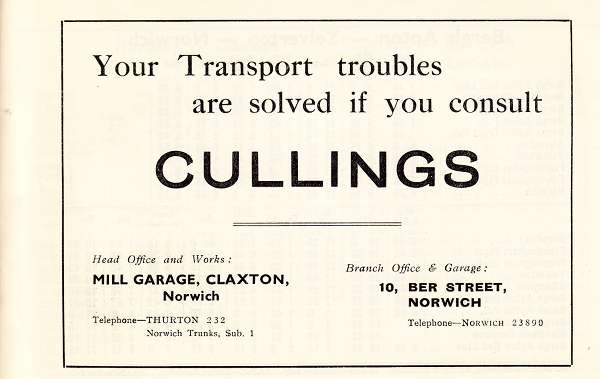
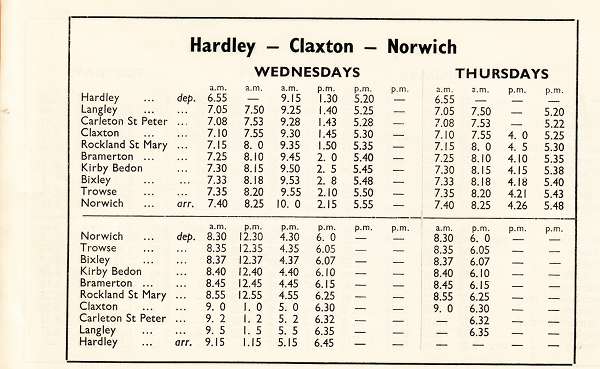
I also thought you might be interested in the attached extracts from the January 1959 timetable.
I walked past the former premises at 10, Ber Street, Norwich last Sunday and some Cullings paint still survives on the top floor office windows.
Nigel Turner
10/02/14 - 09:41
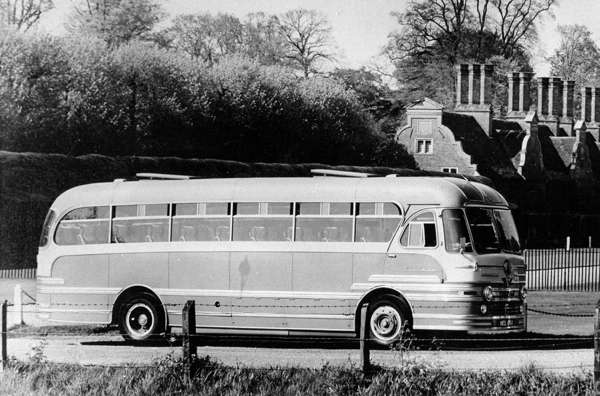
I attach a photo given to me by the vehicles one time driver. It shows an AEC Reliance HCL 661 with Yates Riviera C41C body which I was told passed to Red Car Service (Cullings). The shot was taken at Blickling Hall when the coach was, according to the note on the back, with Broadland Coaches.
I recall seeing this coach several times at Ber Street and rode on it once.
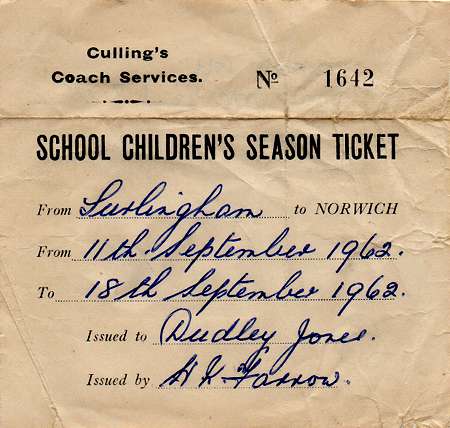

I also attach a Cullings Surlingham - Norwich season ticket and a Cullings Automacheckit ticket.
Dudley Jones
10/02/14 - 17:53

Like Dudley I still have one of my season tickets, also signed by Mr farrow, and a couple of bus tickets.
The Yeates AEC in the Red Car fleet was HCL 764, which was identical to the Broadland Hickling photo.
My list of double-deckers the same as Dudley's. However DLU 406 retained its roof box for a short while and given the number 7 instead of 6. Could this have been an error. The box was removed shortly afterwards.
Wally Nickerson
26/02/14 - 12:57
In response to the above post by Dudley Jones, Shell did indeed purchase two single-deck Daimler Fleetlines, but they were not for staff transport, they were bodied as racing car transporters. See this link
David Call
27/02/14 - 07:29
Nice to see ex-London Transport STD96 (DLU 406), still with its roof box, although not for much longer. The cab door was a Cullings addition.
Of the 100 of these pseudo-STL's, only 10 were TD4c. However, the torque converters were not to London Transport's liking (pretty much the general view) and were replaced by crash gearboxes at first overhaul in 1939. So it was entirely conventional for Cullings' drivers.
Chris Hebbron
25/04/14 - 09:28
On reflection I take note of the fact that the two single-deck Daimler Fleetlines for Shell are normally referred to as 'tenders' or 'support vehicles'. I don't suppose they would have been much good as transporters - the rear engine would have rather got in the way!
David Call
18/12/14 - 07:00
I have recently located the fleet list I made in the early 1960s. I hope that readers will find its contents interesting.
Cullings had a total of four Bedford SBs with Duple Super Vega C41F bodies.
These all had glass roof lights and were registered:
TVF 800 - UPW 800 - UAH 800 - UNG 800
These were really smart, bought new.
There appear to have been three AEC Reliances with Yeates Europa C41F bodies.
These were registered:
1800 NG - XVF 800 - 2080 NG
All had quarter lights.
These were also bought new and were to a high standard.
In addition Cullings appear to have had a Yeates 'Fiesta' bodied Reliance.
This was 1800 VF.
I suspect from the '1800' registration that this may have been a Red Car vehicle. This seems to have been an Earls Court exhibited vehicle.
KOT 600 was the experimental Dennis Lancet III of 1953.
It was B41F and was ex Aldershot and District demonstrator. This seemed to be a very heavy bus and had, I believe, Strachen body.
My records show it to have been withdrawn in January 1963 and sold 20th February 1963
The AEC Regent IIIs, commented on earlier, were JUO 563 and OTW 922.
JUO 563 (Devon General 563) came in 1961, and OTW 922 in 1962, from Shell Mex.
My records suggest that the Guy Arab was a MK I dating from 1944 with rebuilt Duple UL55R bodywork.
It was ex Greyhound, Sheffield. I have it that it was withdrawn in January 1963 and sold 20 February 1963.
Culling had several Yeates C41C Riviera bodied AECs
These included:
PAH 800 - LNU 931 - HCL764
According to my notes HCL had quarter lights and PAH and LNU were in Red Car livery. PAH must have been new in Culling livery.
Culling also had a Bedford CAV.
This was numbered WNG 800.
These were small vehicles and this may not have been a PSV (?).
Cullings had two Bedford SB's with Yeates Riviera bodies (C36C).
These were quite stylish, but lacking the grace of the AEC Regal IV (?) /Reliances.
They were registered RNB 847 & PVF 800. At least PVF had quarter lights.
I record two Leyland PSU1 coaches with Yeates C41C bodies.
These were MPW 617 & MPW 618.
There was a Full Front Bedford OB which had Plaxton FC29F body. I only rode on this once (it was a sunny day).
I also record a Commer TS3, again with Plaxton body. I have it down as C41C. Registration was JCL 398.
There was a Burlingham Seagull bodied Bedford SB (C41F).
I recall that the vehicle had the later style windows, a late Seagull.
This was registered BEX 450 (which I recognised before I found my list when its photo turned up on E Bay a few months ago). It had quarter lights.
This appears to have come from Caroline Coaches, Great Yarmouth.
I record the Bristol K6B HWW 877 (please see earlier entires above).
Bristol LWL6B with ECW FC37F body was registered OHY 998 and originated with Bristol Tramways.
I also record a Bedford VAL14 of 1964.
This had a Plaxton C52F body and was registered 6694 DK.
It seems to have come from Yelloway of Rochdale (I had crossed out Don Everall).
My final entry is a 1961 AEC Reliance with duple Brittania C43F body.
This was 66 BHO and had come from Creamline, Bordon.
I moved away in 1963/4 (but I still own land as Surlingham) so my list ends there).
I do, much later, remember the Willowbrook dual purpose single deckers that ran a service to Stowmarket.
I hope that the above is of interest.
Mostly it was made by observation but one or two details may have come from Culling staff and from the part time signwriter who did such a good job with the liveries and who lived near me at Surlingham.
Please do let me have any additional information please.
Dudley Jones
19/12/14 - 05:48
Dudley, I'm interested in the Yeates Riviera C41C bodied AECs, in particular LNU 931. This registration was issued in 1947/48. Should it be reversed i.e. 931 LNU? As such it would have been issued in 1958/59 which would make more sense. It's a Derbyshire registration, is there any information as to whom it originated with?
Chris Barker
19/12/14 - 13:56
Regarding 'LNU 931', the best match I have been able to find involving a Reliance has been
UWR 931, MU3RV/Yeates C41F, new to Furness, High Green, 6/57.
However I feel the following is a much better match, even though it doesn't involve a Reliance.
LWU 931, Regal IV 9822E/Yeates C39C, was new to Kitchin, Pudsey, 4/53.
A good question would be, did the vehicle at Cullings have a manual transmission, or was it preselect?
Here's a 1954 shot of LWU931 while with Kitchin's..
..and an undated shot, apparently taken at Great Yarmouth. That's suspicious!
David Call
20/12/14 - 11:51
A close look at the photo of LWU 931 in David Call's Flickr link shows Culling's windmill logo on the front panel which confirms his suspicions.
Nigel Turner
20/12/14 - 12:36
I think that the vehicle must be one shown in the picture at Yarmouth.
Too much of a co-incidence.
The picture may have been taken before repainting, or it could be in Red Car Livery
Dudley Jones
PS I always thought it likely that these were Regal IVs, as they struck me as several years old (but still smooth and a good ride).
Albert Culling also owned, for some time after 1964, a 500cc Jap powered speedway racing motorbike bought from the auction at the Firs stadium, Nowich and named 'Norwich Number 2 Track Spare'.
This machine later past to 5 times World Champion Ove Fundin, who won his titles on the machine which was kept specifically for him when he rode for Norwich.
25/12/14 - 07:12
Dudley Jones (18/12/14) lists two Leyland Royal Tiger / Yeates coaches, MPW 617 & 618, in the Cullings fleet. Neither appears in the PSV Circle Royal Tiger chassis list or Yeates body list. Any comments?
David Williamson
26/12/14 - 10:45
David Williamson raises an interesting question in his comment regarding MPW617/8. The PSV Circle history published in 1960 lists only MPW618 which it states was a PSU1 with Gurney Nutting (not Yeates) C41C body new in September 1951. However a later amendment sheet notes that the chassis number given (501479) belongs to an East Midland D/D and suggests that it might in fact be 510479. "Bus lists on the web" agrees with 501479 being East Midland PD2/1 KRR84 but does not help with the true identity of the Culling vehicle(s).
Over to the experts!!
Nigel Turner
27/12/14 - 05:31
In trying to track down the above-mentioned Royal tigers I came across the following two shots of CRN 59, the ex-Viking of Preston Strachans-bodied Daimler CVD6.
www.na3t.org/road/photo/HuB0505
www.na3t.org/road/photo/HuB0506
David Call
27/12/14 - 08:54
On the same site are shots of PAH 800.. http://www.na3t.org/road/photo/HuB0508
XVF 800.. http://www.na3t.org/road/photo/HuF0335
and a much later Reliance/Willowbrook, GEX 257N http://www.na3t.org/road/photo/RS00940
Of the vehicles listed in Dudley J's fleet list, 1800 NG, HCL 764, and JCL 398 are recorded by BLOTW as having been new to Red Car. JCL is listed as having had a Duple, rather than a Plaxton, body
David Call
28/12/14 - 06:17
Prompted by Nigel Turner's comments (26/12/14), I looked again at the PSV Circle Royal Tiger chassis list and found that MPW 618 is indeed included, recorded as chassis number 510479 with Gurney Nutting C41C body, new in 1951. However, MPW 617 remains a mystery. Whilst searching, I came across a slightly newer (1952) Gurney Nutting bodied coach of Culling's, NNG 190, a Dennis Lancet J10A with FC39F body.
David Williamson
28/12/14 - 16:12
Thanks to correspondents for the additional information.
I originally had JCL 398 down as a Duple bodied vehicle, and over-wrote Plaxton for some reason.
When I first moved to Norfolk Cullings had several Dennis Lancet half cabs with Duple or similar coach bodies.
I recall watching several arrive back at Ber Street one after the other one evening.
My notes do not record, funnily enough, the little Commer bus that was a regular to Berg Apton. It regularly accommodated 50+ in its 31 seat body when it went to Surlingham, and went like a rocket.
Dudley Jones
29/12/14 - 06:34
Here are a couple of shots of the Saro-bodied Commer mentioned above.
http://www.sct61.org.uk/zzoua76a
http://www.sct61.org.uk/zzoua76b
The photographer (John Kaye) seemed satisfied that the body was Saro, so it probably was, but it does seem to have been a little out of keeping with most Saro bodies.
David Call
02/02/15 - 08:47
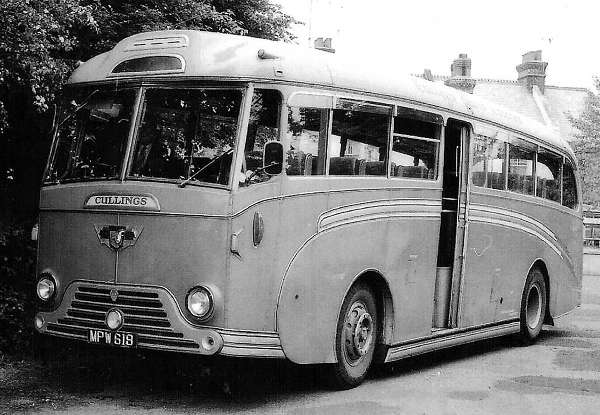
AEC Regal LWU 931 was badged as a Maudslay when exhibited at the Commercial Motor show. As far as I am aware there was no vehicle registered LNU 931 in Cullings Fleet.
MPW 618 Royal Tiger Gurney Nutting pictured above was new in 1951. Again not aware of a MPW 617 in Cullings fleet.
DCR 865 had body rebuild by Brush.
There were four Tilling Stevens half cabs new to Cullings 1948 onwards JAH 569, JNG 596, KVF 587 and LAH 924. Photos of any of these vehicles have eluded me so far.
Please could anyone help. I am so enthusiastic regarding Cullings please keep posting.
Wally Nickerson
28/09/15 - 07:08
As a schoolboy in 1969 I was a regular passenger on the Cullings Yeates-bodied Reliances, when Cullings had one of the contracts for County Grammar School, later Wymondham College. On our Old Costessey to Wymondham route we usually got 1800 NG or 2080 NG, sister ship XVF 800 usually did New Costessey. 1800 VF also made a few appearances, till it was wrecked in 1972 - I remember seeing the crash pics in the Evening News.
Richard Wilson
29/09/15 - 07:13
Here's a turn up for the book - photographic evidence that CRN 59 operated for Morley's of Whittlesey. Almost certainly after its service with Cullings. See it at this link
David Call
08/01/16 - 11:15
I came across this website whilst looking on-line for old images of the village of Hainford. I note that one of the images posted above by Wally Nickerson (05/02/14 - 07:02) states that it is "not Hall Road Hainford this time". I wonder therefore please if anyone has any old images of transport in Hall Road Hainford? I would be very grateful to hear from them if they have. Some villagers are trying to gather as many old photos of the village as we can to create an archive.
Sally Fletcher
08/03/16 - 15:26
I am a descendant of the CULLING families in Norfolk and Suffolk. I have been researching the families for many years and in April 1st will be giving a talk to my CULLING relatives here in Western Australia.
I would very much like to include some photos of the CULLING’S COACHES. Would you please let me know if you are willing to let me use copies for my PowerPoint Presentation? I will of course make sure I reference your collection and direct the family to your website.
Diane Foster (nee CULLING)
Comments regarding the above are more than welcome please get in touch via the 'Contact Page' or by email at obp-admin@nwframpton.com
All rights to the design and layout of this website are reserved
Old Bus Photos from Saturday 25th April 2009 to Wednesday 3rd January 2024